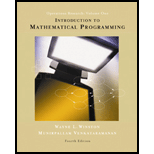
Concept explainers
Explanation of Solution
Solving the LP using simplex
Given,
Maximize
Subject to,
Converting to standard form:
As,
The standard form of LP problem becomes,
Maximize,
Subject to,
and
Converting LP to canonical form:
The LP is converted to canonical form by adding slack, surplus and artificial variables as appropriate. This is done as given below,
As the constraint “
For the constraint “
Thus the LP becomes,
Maximize
Subject to,
Iteration 1:
| 2 | 1 | -1 | 0 | 0 |
Min Ratio | |||
| 0 | 6 | (3) | 1 | -1 | 1 | 0 | ||
| 0 | 4 | 1 | 1 | -1 | 0 | 1 | ||
| z=0 | 0 | 0 | 0 | 0 | 0 | |||
| -1 | 1 | 0 | 0 |
Negative min
Minimum ratio is 2 and its row index is 1,
Want to see the full answer?
Check out a sample textbook solution
Chapter 4 Solutions
Introduction to mathematical programming
 Operations Research : Applications and AlgorithmsComputer ScienceISBN:9780534380588Author:Wayne L. WinstonPublisher:Brooks Cole
Operations Research : Applications and AlgorithmsComputer ScienceISBN:9780534380588Author:Wayne L. WinstonPublisher:Brooks Cole
